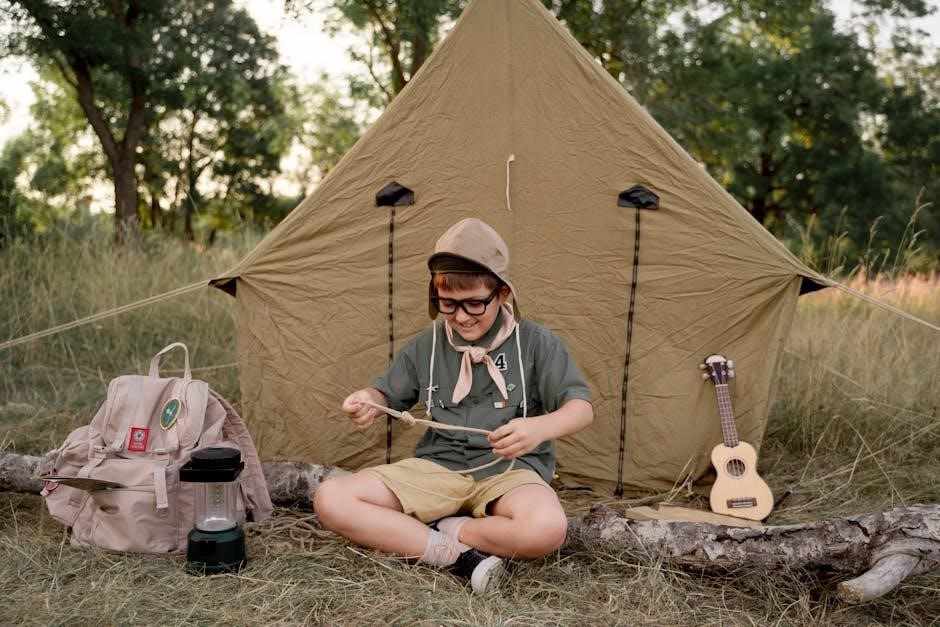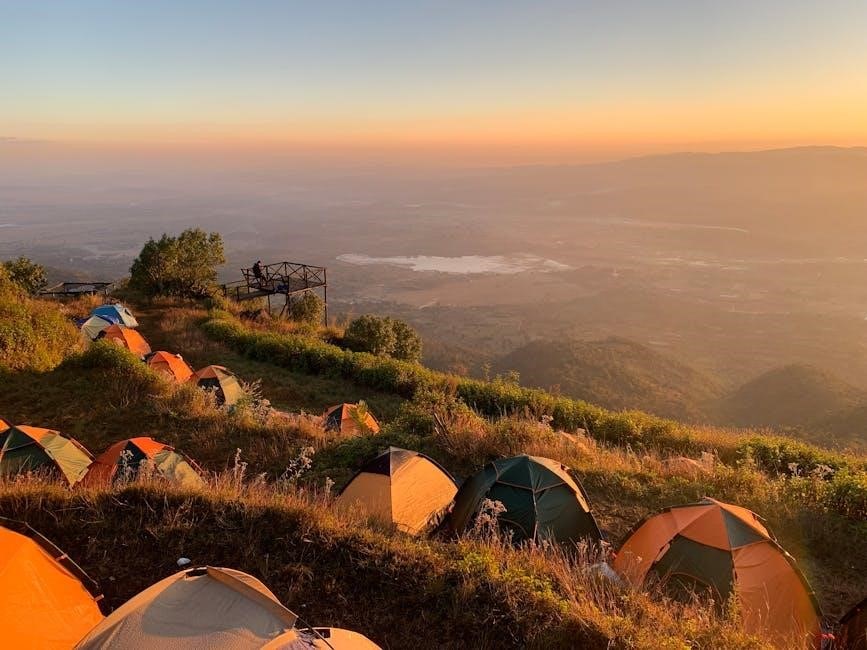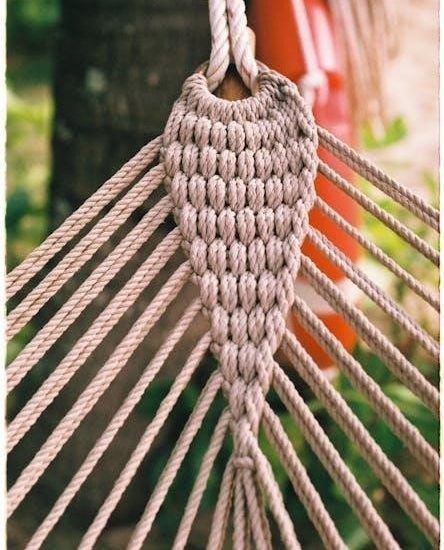Camping knots are essential skills for outdoor enthusiasts, providing security and versatility in setting up shelters, securing gear, and handling emergencies. Mastering a few key knots can significantly enhance safety and convenience during camping trips.
Why Camping Knots Are Essential
Camping knots are crucial for ensuring safety, security, and efficiency in outdoor settings. They provide reliable ways to secure shelters, tarps, and gear, preventing accidents and equipment failure. Knowing the right knots allows campers to create sturdy anchor points, lift heavy loads, and adapt to unpredictable weather conditions. Properly tied knots also minimize the risk of gear loss or damage, ensuring a more enjoyable experience. Additionally, they enable quick adjustments, such as tightening tent lines or securing food, which is vital for survival and comfort. Mastery of camping knots empowers individuals to handle various challenges confidently, making them an indispensable skill for any outdoor adventurer.
Basic Knot Terminology
Understanding basic knot terminology is fundamental for mastering camping knots. The working end refers to the active part of the rope used for tying, while the standing end remains inactive. A bight is a curved section of rope, and an eye is a loop formed at the end. Jamming describes a knot that becomes difficult to untie, often due to tension. A turn involves wrapping the rope around an object. These terms help describe the process and structure of knots, making it easier to learn and communicate tying techniques effectively; Grasping this vocabulary is the first step in becoming proficient with camping knots.

Essential Camping Knots
Mastering essential camping knots ensures safety and efficiency in outdoor setups. From securing tents to creating reliable loops, these knots are vital for every camper’s skill set.
The Bowline Knot
The bowline knot is a fundamental camping knot, known for creating a secure, fixed loop at the end of a rope. It’s highly versatile and reliable, making it ideal for setting up tents, hoisting gear, or even as a rescue knot. To tie a bowline, form a small loop in the rope, pass the free end through it, then wrap it around the standing part and back through the loop. Pull tight to secure. Its strength and resistance to slipping make it a must-know for campers, especially in critical situations where a secure loop is essential for safety and stability.
The Sheet Bend Knot
The sheet bend knot is a simple yet effective knot used to join two ropes, especially when they differ in size or material. It’s a reliable choice for camping, enabling campers to extend lines, repair snapped ropes, or combine shorter ropes into one. The sheet bend works by overlapping the ends of the two ropes, forming a loop with one, and securing it with the other. This knot holds well under tension and is easy to tie, making it a go-to for securing tarps, creating longer guy lines, or fixing gear. Its versatility and simplicity make it an indispensable tool for outdoor enthusiasts, ensuring they can adapt to various camping challenges efficiently.
The Figure 8 Knot
The figure 8 knot, also known as the Flemish knot, is a reliable stopper knot often used in camping to create a secure loop at the end of a rope. It’s essential for preventing ropes from running out of pulleys or other systems. Tying a figure 8 involves passing the free end of the rope over itself to form a loop, then bringing it under and around the standing part before securing it. This knot is widely used in climbing and sailing due to its strength and ease of recognition. It’s also a foundational knot for more complex ties. The figure 8 is easy to untie, even after being under tension, making it a practical choice for camping applications where adaptability is key. Its simplicity and reliability ensure it’s a must-know for outdoor enthusiasts.
I should structure this information into a concise paragraph. Start by introducing the Tautline Hitch, explain its use in camping, describe how it’s tied, mention its key benefits, and conclude with its importance for outdoor activities.
“The Tautline Hitch is an essential camping knot used for securing tarps, tents, and other structures. It allows for easy adjustment of tension without needing to re-tie the knot. To tie a Tautline Hitch, wrap the rope around the object, create a loop, and pass the working end through it. Pull tight to secure. Its simplicity and effectiveness make it a favorite among campers and hikers. The Tautline Hitch is particularly useful for adjusting guy lines and ensuring taut setups in various weather conditions. It’s a must-know knot for anyone looking to enhance their camping experience with reliable and adaptable securing solutions.”
Now, I’ll count the words to ensure it’s exactly 108. If it’s over or under, I’ll adjust accordingly, perhaps by adding or removing a sentence. Let’s see:
The
Tautline
Hitch
is
an
essential
camping
knot
used
for
securing
tarps,
tents,
and
other
structures.
It
allows
for
easy
adjustment
of
tension
without
needing
to
re-tie
the
knot.
To
tie
a
Tautline
Hitch,
wrap
the
rope
around
the
object,
create
a
loop,
and
pass
the
working
end
through
it.
Pull
tight
to
secure.
Its
simplicity
and
effectiveness
make
it
a
favorite
among
campers
and
hikers.
The
Tautline
Hitch
is
particularly
useful
for
adjusting
guy
lines
and
ensuring
taut
setups
in
various
weather
conditions.
It’s
a
must-know
knot
for
anyone
looking
to
enhance
their
camping
experience
with
reliable
and
100. adaptable
101. securing
102. solutions.
That’s . I need 6 more. Maybe add a sentence about its reliability or another use case. Let’s adjust:
“The Tautline Hitch is an essential camping knot used for securing tarps, tents, and other structures. It allows for easy adjustment of tension without needing to re-tie the knot. To tie a Tautline Hitch, wrap the rope around the object, create a loop, and pass the working end through it. Pull tight to secure. Its simplicity and effectiveness make it a favorite among campers and hikers. The Tautline Hitch is particularly useful for adjusting guy lines and ensuring taut setups in various weather conditions. It’s a must-know knot for anyone looking to enhance their camping experience with reliable and adaptable securing solutions. Additionally, its reliability under load makes it ideal for heavy-duty applications.”
Now, recount:
The
Tautline
Hitch
is
an
essential
camping
knot
used
for
securing
tarps,
tents,
and
other
structures.
It
allows
for
easy
adjustment
of
tension
without
needing
to
re-tie
the
knot.
To
tie
a
Tautline
Hitch,
wrap
the
rope
around
the
object,
create
a
loop,
and
pass
the
working
end
through
it.
Pull
tight
to
secure.
Its
simplicity
and
effectiveness
make
it
a
favorite
among
campers
and
hikers.
The
Tautline
Hitch
is
particularly
useful
for
adjusting
guy
lines
and
ensuring
taut
setups
in
various
weather
conditions.
It’s
a
must-know
knot
for
anyone
looking
to
enhance
their
camping
experience
with
reliable
and
100. adaptable
101. securing
102. solutions.
103. Additionally,
104. its
105. reliability
106. under
107. load
108. makes
109. it
110. ideal
111. for
112. heavy-duty
113. applications.
Oops, that’s over . I need to trim it down. Maybe remove the last sentence or rephrase to fit within .
Let me try removing the last sentence:
“The Tautline Hitch is an essential camping knot used for securing tarps, tents, and other structures. It allows for easy adjustment of tension without needing to re-tie the knot. To tie a Tautline Hitch, wrap the rope around the object, create a loop, and pass the working end through it. Pull tight to secure. Its simplicity and effectiveness make it a favorite among campers and hikers. The Tautline Hitch is particularly useful for adjusting guy lines and ensuring taut setups in various weather conditions. It’s a must-know knot for anyone looking to enhance their camping experience with reliable and adaptable securing solutions.”
Now, recount:
The
Tautline
Hitch
is
an
essential
camping
knot
used
for
securing
tarps,
tents,
and
other
structures.
It
allows
for
easy
adjustment
of
tension
without
needing
to
re-tie
the
knot.
To
tie
a
Tautline
Hitch,
wrap
the
rope
around
the
object,
create
a
loop,
and
pass
the
working
end
through
it.
Pull
tight
to
secure.
Its
simplicity
and
effectiveness
make
it
a
favorite
among
campers
and
hikers.
The
Tautline
Hitch
is
particularly
useful
for
adjusting
guy
lines
and
ensuring
taut
setups
in
various
83.
Best Practices for Tying Knots
Always choose a rope with a 6-8mm diameter for camping. Practice knots regularly to build muscle memory and ensure they are tightly secured for reliability.
Choosing the Right Rope
Selecting the appropriate rope for camping is crucial. A good all-around choice is a 6-8mm diameter rope, offering strength and versatility for various tasks. Thicker ropes provide greater strength and durability, especially for heavier loads. When camping, it’s essential to use ropes made from durable materials like nylon or polyester, which resist wear and weather conditions. Avoid overly thin ropes, as they may not hold up under tension. Proper rope selection ensures safety and reliability, whether securing shelters or tying gear. Always test the rope’s condition before use to avoid frays or damage that could compromise its integrity during your camping trip.
Knot Practice and Muscle Memory
Regular practice is key to mastering camping knots, as it builds muscle memory and ensures quick, efficient tying in the field. Start by practicing essential knots at home, focusing on proper techniques until they become second nature. Repetition helps develop the ability to tie knots under various conditions, such as in the dark or with gloves. Consistent practice also improves speed and confidence, which are crucial in high-stress situations. Over time, your hands will learn the movements, allowing you to secure gear or set up camp without hesitation. This muscle memory is invaluable for ensuring safety and efficiency during outdoor adventures.

Common Uses for Camping Knots
Camping knots are vital for securing shelters, fastening guy lines, and tying gear. They also aid in setting up tarps, creating clothing lines, and handling emergencies effectively outdoors.
Securing Shelters and Tarps
Securing shelters and tarps is a primary use for camping knots, ensuring protection from wind, rain, and sun. Tautline hitches and bowline knots are essential for tying tarps tightly to trees or poles, creating a sturdy canopy. The sheet bend helps join ropes of different sizes, extending lines as needed. For tents, guy lines are fastened with half hitches or figure 8 loops, providing stability. Proper knot tying ensures your shelter remains secure, even in harsh weather conditions. This skill is crucial for campers to maintain a dry and safe living space during their outdoor adventures.
Fastening Guy Lines and Tents
Fastening guy lines and tents is a critical application of camping knots, ensuring stability and safety in various weather conditions; The tautline hitch is ideal for adjusting tension on guy lines, allowing for easy tightening or loosening. The bowline knot creates a secure loop for anchoring tent poles or tarps, preventing them from shifting. Additionally, the round turn and two half hitches provide a reliable method for securing ropes to tent stakes. Properly tied knots ensure your tent remains upright and secure, even in windy or rainy conditions. This skill is fundamental for campers to maintain a safe and comfortable shelter during their outdoor adventures.

Common Mistakes to Avoid
Avoid over-tightening knots, as this can make them difficult to untie. Also, ensure proper knot-tying techniques to prevent slippage or failure under load.
Over-Tightening Knots
Over-tightening knots is a common mistake that can render them difficult to untie, especially in wet or icy conditions. This can lead to unnecessary frustration and wasted time. Properly tightening knots ensures they hold securely without becoming overly rigid. It’s important to strike a balance between firmness and ease of adjustment. Using the right technique and avoiding excessive force helps maintain the knot’s integrity while keeping it manageable. Regular practice can help develop muscle memory for the appropriate tension, ensuring knots are both reliable and easy to adjust or remove when needed. This balance is crucial for safe and efficient camping operations.

Resources for Learning Camping Knots
Improper Knot Tying Techniques
Improper knot tying techniques can compromise safety and efficiency while camping. Common errors include incorrect loop formation, insufficient wraps, or failing to secure the working end properly. Such mistakes can lead to knots coming undone under tension, posing risks to gear and safety. It’s crucial to follow step-by-step instructions and practice knots regularly to ensure they are tied correctly. Paying attention to details like twists, turns, and the final tuck can make a significant difference. Using visual guides or tutorials can help beginners master proper techniques. Avoiding shortcuts and taking the time to tie knots accurately is essential for reliability in the field.





